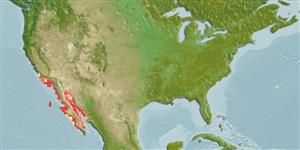Common names from other countries
>
Eupercaria/misc (Various families in series Eupercaria) >
Haemulidae (Grunts) > Haemulinae
Etymology: Anisotremus: Greek, anisos = unequal + Greek, trema, -atos = hole (Ref. 45335).
More on author: Steindachner.
Environment: milieu / climate zone / depth range / distribution range
Ökologie
seewasser demersal; tiefenbereich 0 - 40 m (Ref. 2850), usually ? - 8 m (Ref. 2850). Subtropical; 39°N - 22°N, 124°W - 106°W
Eastern Central Pacific: Santa Cruz in central California, USA to southern Baja California, Mexico; isolated population in the Gulf of California.7
Size / Gewicht / Alter
Maturity: Lm ? range ? - ? cm
Max length : 58.0 cm TL Männchen/unbestimmt; (Ref. 2850); max. veröff. Alter: 15 Jahre (Ref. 56049)
Occur in coastal waters, frequently in rocky reefs and occasionally over sandy bottoms (Ref. 9114); often near kelp beds. Juveniles form schools in littoral pools (Ref. 9114). Feed on crustaceans, mollusks and bryozoans. Pelagic spawner (Ref. 56049). Marketed fresh (Ref. 9114).
Distinct pairing during breeding (Ref. 205). Pelagic spawner (Ref. 56049).
Eschmeyer, W.N., E.S. Herald and H. Hammann, 1983. A field guide to Pacific coast fishes of North America. Boston (MA, USA): Houghton Mifflin Company. xii+336 p. (Ref. 2850)
IUCN Rote Liste Status (Ref. 130435)
CITES (Ref. 128078)
Not Evaluated
Bedrohung für Menschen
Harmless
Nutzung durch Menschen
Fischereien: weniger kommerziell; Sportfisch: ja
Tools
Zusatzinformationen
Download XML
Internet Quellen
Estimates based on models
Preferred temperature (Ref.
115969): 15.2 - 23.3, mean 21.1 (based on 116 cells).
Phylogenetic diversity index (Ref.
82804): PD
50 = 0.5039 [Uniqueness, from 0.5 = low to 2.0 = high].
Bayesian length-weight: a=0.01738 (0.00807 - 0.03743), b=3.02 (2.83 - 3.21), in cm Total Length, based on LWR estimates for this (Sub)family-body shape (Ref.
93245).
Trophic level (Ref.
69278): 3.5 ±0.46 se; based on food items.
Widerstandsfähigkeit (Ref.
120179): mittel, Verdopplung der Population dauert 1,4 - 4,4 Jahre. (tm=2; tmax=15).
Fishing Vulnerability (Ref.
59153): Moderate vulnerability (43 of 100).
